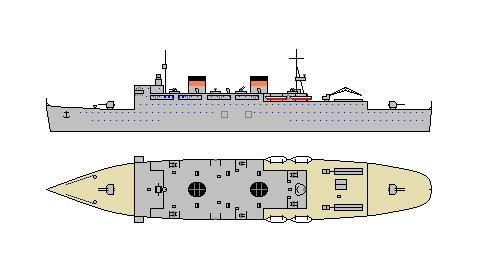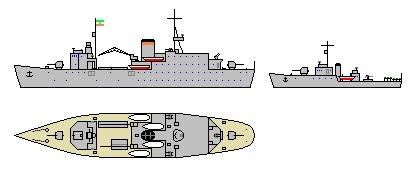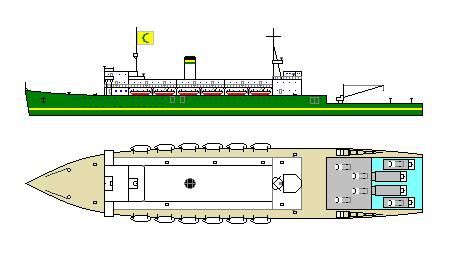Petty Officer Surinder Grival Class Submarine Tender
With the recent upswing in Indian pilgrims embarking on the Hajj to Mecca, Indian passenger ship lines are replacing their “older” ships with newer, larger, faster vessels capable of meeting the increased demand for service. As these new ships become available, the older ships are being sold for a song to local buyers - and the Bharatiya Nau Sena.
The Navy was able to negotiate the purchase of a quartet of decade-old liners previously owned by the M&J (Mumbai and Jiddah) Steamship Company as the company introduced new liners of ~11,000 t into service. These vessels are being refitted to function as submarine tenders, which involves the remodelling of recreational and cargo areas into workshops, storage areas, and torpedo magazines.
The tenders will be capable of housing the crews of up to a dozen typical coastal submarines (~40 men per boat) or a lesser number of ocean-going submarines. Limited flag and medical facilities are also provided.
Four vessels are slated for requisition and refitting between 1932 and 1934.

Petty Officer Surinder Grival, AT-9, laid down 1922, refitted to service 1932
Seaman Himanshi Bagchi, AT-10, laid down 1922, refitted to service 1933
Gunner Santosh Mattoo, AT-11, laid down 1923, refitted to service 1933
Seaman Ansar Hamidullah, AT-12, laid down 1923, refitted to service 1934
Grival, laid down 1922, refitted 1932
Length, 116.0 m x Beam, 18.4 m x Depth, 4.0 m
4734 tonnes normal displacement (3963 tonnes standard)
Main battery: 4 x 10.5-cm
Secondary battery: 8 x 3.5-cm
AA battery: 8 x 1.5-cm
Weight of broadside: 69 kg
Hull unarmored
Battery armor:
Main, 3.0 cm shields / secondary, 2.0 cm shields
AA, 2.0 cm shields
Maximum speed for 2397 shaft kw = 14.44 knots
Approximate cruising radius, 14000 nm / 12 knots
Typical complement: 285-371
Misc weight distribution:
-1100 t: Sub crew quarters (550 at 2 t each)
-50 t: Flag facilities
-50 t: Medical facilities
-200 t: Workshops
-400 t: Parts warehouse
-100 t: Stores and supplies (non-ordnance, fuel)
-40 t: Weight reserve
Estimated cost, $1.813 million (£453,000)
Remarks:
Ship has slow, easy roll; a good, steady gun platform.
Excellent seaboat; comfortable and able to fight her guns
in the heaviest weather.
Magazines and engineering spaces are roomy, with superior
watertight subdivision.
Ship is roomy, with superior accommodation and working space.
Distribution of weights:
Percent
normal
displacement:
Armament ......................... 19 tonnes = 0 pct
Armor, total ..................... 11 tonnes = 0 pct
Armament 11 tonnes = 0 pct
Machinery ........................ 109 tonnes = 2 pct
Hull and fittings; equipment ..... 1777 tonnes = 38 pct
Fuel, ammunition, stores ......... 878 tonnes = 19 pct
Miscellaneous weights ............ 1940 tonnes = 41 pct
-----
4734 tonnes = 100 pct
Estimated metacentric height, 0.8 m
Displacement summary:
Light ship: 3856 tonnes
Standard displacement: 3963 tonnes
Normal service: 4734 tonnes
Full load: 5332 tonnes
Loading submergence 1442 tonnes/metre
+++++++++++++++++++++++++
Estimated overall survivability and seakeeping ability:
Relative margin of stability: 1.08
Shellfire needed to sink: 6245 kg = 390.1 x 10.5-cm shells
(Approximates weight of penetrating
shell hits needed to sink ship,
not counting critical hits)
Torpedoes needed to sink: 2.7
(Approximates number of 'typical'
torpedo hits needed to sink ship)
Relative steadiness as gun platform, 80 percent
(50 percent is 'average')
Relative rocking effect from firing to beam, 0.03
Relative quality as a seaboat: 2.00
+++++++++++++++++++++++++
Hull form characteristics:
Block coefficient: 0.55
Sharpness coefficient: 0.40
Hull speed coefficient 'M' = 6.93
'Natural speed' for length = 19.5 knots
Power going to wave formation
at top speed: 32 percent
Estimated hull characteristics and strength:
Relative underwater volume absorbed by
magazines and engineering spaces: 56 percent
Relative accommodation and working space: 236 percent
Displacement factor: 204 percent
(Displacement relative to loading factors)
Relative cross-sectional hull strength: 0.91
(Structure weight per square
metre of hull surface: 361 kg)
Relative longitudinal hull strength: 2.85
(for 7.00 m average freeboard;
freeboard adjustment +3.02 m)
Relative composite hull strength: 1.02
+++++++++++++++++++++++++
[Machine-readable parameters: Spring Style v. 1.2.1]
380.48 x 60.35 x 13.12; 22.96 -- Dimensions
0.55 -- Block coefficient
1922 -- Year laid down
14.44 / 14000 / 12.00; Oil-fired turbine or equivalent -- Speed / radius / cruise
1940 tons -- Miscellaneous weights
++++++++++
4 x 4.13; 0 -- Main battery; turrets
Central positioning of guns
Gun-shields
:
8 x 1.38; 0 -- Secondary battery; turrets
Gun-shields
:
8 x 0.59 -- Tertiary (QF/AA) battery
Gun-shields
:
0 -- No fourth (light) battery
0 -- No torpedo armament
++++++++++
0.00 -- No belt armor
0.00 / 0.00 -- Deck / CT
1.18 / 0.79 / 0.79 / 0.00 -- Battery armor
(Note: For portability, values are stored in Anglo-American units)
+++++++++++++++++++++++++++++++++++++++++++++++++++++++




